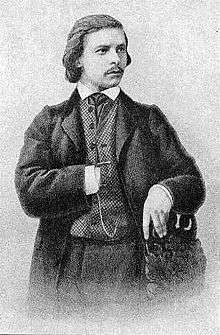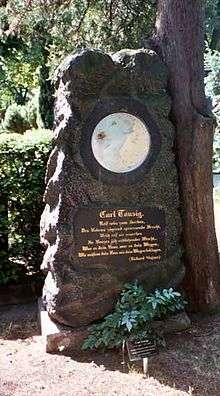Carl Tausig

Carl (or Karl) Tausig (4 November 1841 – 17 July 1871) was a Polish virtuoso pianist, arranger and composer.
Life
Tausig was born in Warsaw to Jewish parents and received his first piano lessons from his father, pianist and composer Aloys Tausig, a student of Sigismond Thalberg. His father introduced him to Franz Liszt in Weimar at the age of 14. He quickly became a favorite pupil of Liszt's, travelling with him on concert tours and studying counterpoint, composition and orchestration in addition to his piano lessons.[1] At the age of 16 he met Richard Wagner, of whom he became a devoted follower and friend. He also became a great admirer and friend of Johannes Brahms. Tausig made piano arrangements of many of Wagner's operas. He also introduced to Wagner his friend Peter Cornelius, another Wagner devotee.
In 1858 Tausig made his debut in Berlin at a concert conducted by Hans von Bülow. While some critics admired his technical feats at the keyboard, others found his playing noisy and overbearing. Even some who were more accommodating of Tausig's "Lisztian eccentricities" felt he would play better as he matured.[2] Tausig toured through various German towns in 1859–60, making Dresden his base. He moved to Vienna in 1862; there he gave concerts of modern orchestral music, including some of his own symphonic poems. These concerts were only partially successful artistically and a failure financially. After staying out of public view for a few years, during which time he married pianist Seraphine von Vrabely (1841–1931), he began touring once again and was now considered a pianist of breadth and dignity of style.[2]

Tausig settled in Germany and opened a piano school in Berlin in 1865 which, however, closed soon afterwards. He toured throughout Europe, but the strain of travelling weakened his health. He died in Leipzig from typhoid at the age of 29.[2] His grave is preserved in the Protestant Friedhof III der Jerusalems- und Neuen Kirchengemeinde (Cemetery No. III of the congregations of Jerusalem's Church and New Church) in Berlin-Kreuzberg, south of Hallesches Tor.
Pianism
Tausig was considered by some critics to be the greatest of Liszt's pupils, pianistically speaking, and to carry pure virtuosity to heights only suggested by Liszt. Anton Rubinstein called him "the infallible."[3] Where Tausig differed from his teacher was in his lack of flamboyant gestures while playing. Tausig sat motionless at the piano and abhorred what he called Spektakel. While his fingers were working miracles at the keyboard without any digital errors, the only sign of tension from Tausig would be a slight tightening of one corner of his mouth.[4]
Until his untimely death, some critics surmise that Tausig may not have had a pianistic equal, combining Liszt's force and range of tone color with the intellectuality of his fellow pupil Hans von Bülow. Another Liszt pupil, Eugen d'Albert, compared Tausig very favorably with their teacher. He said that while Liszt's musical conceptions were grander, Tausig possessed a better and more accurate technique coupled with a good deal of poetry.[5]
Repertory
Tausig's repertory was extensive; he could play from memory works ranging from Scarlatti to Liszt. He was especially noted for his interpretations of Chopin, Weber and Beethoven, both for pianistic finish and intensity of emotion.[2]
Works
Carl Tausig's output as composer is quite small and it is recorded by the composer and virtuoso pianist Artur Cimirro for the cd label Acte Prealable. As well as entirely original works, he arranged for piano music of a number of composers, and wrote a number of pedagogic works (works for teaching and practice).
Tausig's surviving output is for piano solo only. Where indicated, unpublished works are shown. Some further works are also unpublished or lost, and are not listed – these include a transcription in double notes of Chopin's Étude Op. 25, No. 2, and orchestral compositions (including a piano concerto and an orchestral version of Das Geisterschiff).
Of Tausig's original compositions and numerous arrangements of classical works the following may be mentioned: Deux Études de Concert, replacing an earlier pianoforte transcription of his symphonic ballad Das Geisterschiff; Ungarische Zigeunerweisen, a composition for pianoforte; Nouvelles Soirées de Vienne; Tägliche Studien, finger exercises of high value; a selection of studies from Clementi's Gradus ad Parnassum; a transcription of Bach's Toccata and Fugue in D minor, BWV 565; and adaptations of Weber's Invitation to the Dance, and of six Beethoven quartets; transcriptions of Schubert's Marche Militaire No. 1 in D and of Wagner's Die Meistersinger von Nürnberg, The Ride of the Valkyries, and Siegmund's Love Song. His arrangement of Johann Strauss II Man lebt nur einmal! has been recorded by Ignacy Jan Paderewski in New York.
Original compositions
- Impromptu, Op. 1a
- Das Geisterschiff (Ballade), Op. 1b
- Deux Études de Concert, Op. 1c
- Introduction and Tarantella, Op. 2a
- L'Espérance (nocturne varié), Op. 3
- Rêverie, Op. 5
- Le Ruisseau, Op. 6a
- Ten Préludes
- Ungarische Zigeunerweisen
- Valse-Caprice (published as Nos. 4 and 5 following on from J. Strauss transcriptions, given below)
Transcriptions
Some of these works were left incomplete by Tausig; where possible, details of the state of the manuscript are given.
- J. S. Bach: (6) Chorale Preludes (BWV 1098, 614, 622, 656, ???, 648)
- Bach: Praeludium, Fuge und Allegro, BWV 998
- Bach: Toccata and Fugue in D minor, BWV 565
- Beethoven: Sechs Sätze aus Streichquartetten
- Berlioz: Gnomenchor und Sylphentanz
- Chopin: Piano Concerto No. 1 in E minor
- Liszt: Les préludes (Published by Editio Musica Budapest)
- Liszt: Tasso (essentially complete, only last 4 bars not finished; completed and published by Bellisarius edition?)
- Liszt: Hamlet (unpublished)
- Liszt: Orpheus (no phrasing, dynamics or tempo markings; unpublished)
- Liszt: Die Ideale (last 25 bars incomplete; unpublished)
- Liszt: Hungaria (last 13 bars incomplete; unpublished)
- Liszt: Ce qu'on entend sur la montagne (unpublished)
- Liszt: Heroïde funèbre (no phrasing, dynamics or tempo markings; unpublished)
- Liszt: Faust Symphony (Gretchen incomplete, remainder mostly complete; unpublished)
- Liszt: Dante Symphony (unpublished)
- Moniuszko: Reminiscences de Halka
- Scarlatti: Five Sonatas
- Schubert: Andantino und Variationen, Op. 84, No. 1
- Schubert: Marche Militaire, Op. 51, No. 1
- Schubert: Polonaise, Op. 75, No. 3
- Schubert: Rondo, Op. 84, No. 2
- Schumann: Die Contrabandiste
- J. Strauss II: Nouvelles soirées de Vienne (Valses-caprices Nos. 1–3)
- Wagner: Die Meistersinger von Nürnberg (solo piano and four hand arrangement)
- Wagner: Kaiser-Marsch
- Wagner: Meditation from Die Meistersinger von Nürnberg
- Wagner: Three paraphrases on Tristan und Isolde
- Wagner: Two transcriptions from Die Walküre
- Weber: Invitation to the Dance
Tausig also arranged another three of Liszt's symphonic poems but the manuscripts are not sufficiently intact to be accessible. See Dennis Hennig's article in the Liszt Society (UK) Journal volume 17 (1992), p. 65 for more details.
Discographie
- 2016 : Acte Préalable AP0359 – Karol Tausig - Complete Original Piano Works (Artur Cimirro)
Media
 |
|
| Problems playing this file? See media help. | |
References
Bibliography
- Dannreuther, Edward, ed. Stanley Sadie, "Tausig, Carl [Karol]," The New Grove Dictionary of Music and Musicians, Second Edition, 29 vols. (London: Macmillan, 2001). ISBN 1-56159-239-0.
- Schonberg, Harold C., The Great Pianists (New York: Simon & Schuster, 1987, 1963). ISBN 0-671-64200-6.
External links
- Works by or about Carl Tausig at Internet Archive
- Free scores by Carl Tausig at the International Music Score Library Project
- http://www.bach-cantatas.com/Lib/Tausig-Carl.htm
- http://jewishencyclopedia.com/view.jsp?artid=86&letter=T
- http://www.usc.edu/dept/polish_music/PMJ/issue/6.1.03/greatestpianists.html
-
 "Tausig, Karl". New International Encyclopedia. 1905.
"Tausig, Karl". New International Encyclopedia. 1905. -
 "Tausig, Karl". Encyclopedia Americana. 1920.
"Tausig, Karl". Encyclopedia Americana. 1920.